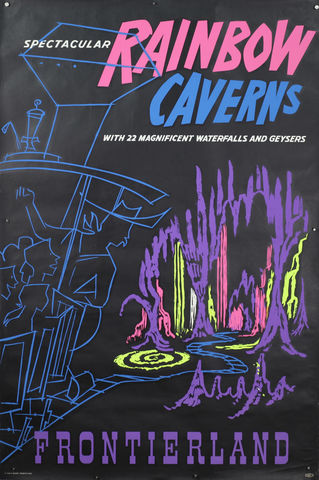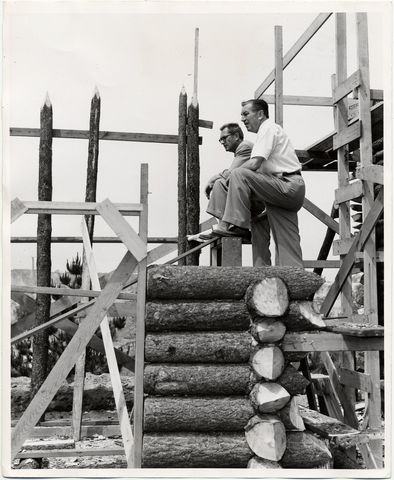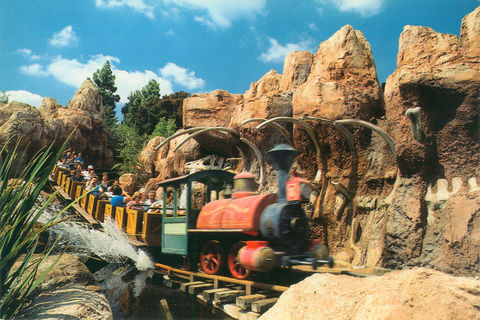Ask any dedicated Disney fan and they will tell you: Walt loved trains. “Trains were a part of his whole psyche, I think,” Disney Legend Tony Baxter shared in the Disney+ Original Series Behind the Attraction. “He had his own backyard railroad with a featured engine—the Lilly Belle—named after his wife. So when Disneyland opened, [there] was a lot about trains, because that was Walt’s hobby.”
Another of Walt’s great loves was the history of America’s wild frontier—so what finer way to enhance his new Disneyland park than by creating its very own bustling Old West town, complete with locomotive? In 1956, Walt proudly unveiled a new feature of Frontierland: Rainbow Ridge. At its center was the Rainbow Caverns Mine Train, a leisurely attraction that ferried guests near the sights and sounds of this old-fashioned town. The climax of the ride was a trip through a mountain, where colorful waterfalls flowed and fluorescent stalactites hung from the roof.

Mine Train Through Nature’s Wonderland
The Rainbow Caverns Mine Train was well-received by guests, but Walt knew that it had room for improvement. And so, in 1960—five years after Disneyland’s opening—the attraction was relaunched and renamed as Mine Train Through Nature’s Wonderland. “They’re essentially the same attraction, but Mine Train Through Nature’s Wonderland was a great expansion of it,” explained Disney historian Jim Fanning.
More than 200 AUDIO-ANIMATRONICS® creatures—from reptiles and birds to beavers and bears—were installed in Frontierland as part of this expansion, which took inspiration from Walt’s True-Life Adventures series of nature documentaries. Disneyland’s guests appreciated the new faux wildlife around them, but the real-life Anaheim animals weren’t so keen. “Right after the first birds were installed, a big ruckus was going on,” recalled Disney Legend Bob Gurr, who was responsible for designing the attraction’s ore cars. “Seems the real birds resented the presence of the phony birds and were pecking them to bits.”
One of Walt’s already-acclaimed animators, Disney Legend Marc Davis, had been brought into the Imagineering team in the 1960s to inject new life and humor into some of the more straight-laced and educational Disneyland attractions, such as the Jungle Cruise. Davis took the same approach for Mine Train Through Nature’s Wonderland at Walt’s request, but even with his iconic humor now added to the mix, the attraction slowly began to lose steam over the 1960s. While it remained a favorite for some, it eventually lacked the thrills that many guests were expecting when they visited Disneyland. “It was poky. It was slow,” explained Disney author Tim O’Day.
From Disneyland to Walt Disney World
Following Walt’s death in 1966, his brother Roy O. Disney and a dedicated team of Imagineers—including Marc Davis—got to work bringing Walt’s vision for a brand-new Disney themed entertainment concept to life near Orlando, Florida.
With the knowledge that their Floridian audience was more than familiar with local pirate-themed lore, the team decided that Disneyland’s Pirates of the Caribbean attraction would not be recreated in Walt Disney World. Instead, Walt’s love of the Old West would be celebrated once more—this time, with a large, multi-attraction Western-themed attraction area named Thunder Mesa. This vast concept, which came from the mind of Marc Davis, would feature a Pirates-esque boat ride: the Western River Expedition.
But when guests started to visit the newly opened Walt Disney World in the early 1970s, one thing quickly became clear: those Disneyland pirates were popular! “The public was starting to become very vocal about, ‘If you’re gonna go to a Disney park, go to California, because the new ride they opened out there—Pirates of the Caribbean—is way beyond anything in Walt Disney World,’” recalled Tony Baxter.
The Imagineers listened. Work to create a Floridian Pirates of the Caribbean hastily began, and Davis’s Western River Expedition was temporarily halted.

The Beginnings of Big Thunder
With Imagineering’s focus now firmly on Pirates of the Caribbean, the future of Thunder Mesa looked uncertain—which was disappointing not only for Davis, but also for his fresh-faced mentee: Imagineer and Disney Legend Tony Baxter. As Baxter pored over Davis’s original drawings of Thunder Mesa and its potential Western-themed rides, one particular idea stood out to him. “On the front of his attraction, he had the appearance of a mine train ride,” said Baxter. “It wasn’t developed enough to know if it was going to be fun and thrilling. I was very inspired by that, and I knew I had to extract it while trying not to offend Marc.”
Baxter spoke with Disney executive and Disney Legend Card Walker to convince him that this small part of Thunder Mesa was both worth saving and a financially savvy decision. Walker agreed, and Big Thunder became Baxter’s project. Poignantly, this was to be the first large-scale Disney parks attraction created without any involvement from Walt himself.
Work on Big Thunder took a backseat in the mid-1970s, as Imagineering’s focus moved over to the development of Space Mountain, which opened in the Magic Kingdom at Walt Disney World in 1975, and at Disneyland in 1977. However, Baxter’s project list grew again when he received a call from Disneyland with a request to update one of its classic attractions. Mine Train Through Nature’s Wonderland, now well over a decade into its existence, was beginning to look and feel tired—its outdated AUDIO-ANIMATRONICS figures and leisurely spiel didn’t fit so well within a changing park. “Guests, especially young guests, were seeking thrill attractions,” explained Jim Fanning.
“They said, ‘Well, we really liked what you were doing in Florida for that thing called Big Thunder. Could you make that work at Disneyland?’” recalled Tony. “And I was so thankful that there might be a way to keep it going rather than shutting it down while Space Mountain happened, that I said, ‘Well, yeah, sure.’”

Thundering Around The World
Disneyland’s Big Thunder Mountain Railroad opened in September 1979, closely followed by Walt Disney World’s in September 1980—and guests were delighted. Big Thunder Mountain Railroad remains one of Disney’s most beloved attractions, with consistently high ridership and dedicated fans all over the world.
Interestingly, different versions of the attraction pay homage to Walt’s team of Imagineers—particularly Marc Davis. In Hong Kong, the Big Grizzly Mountain Runaway Mine Cars pass through an area named Grizzly Gulch, which houses AUDIO-ANIMATRONICS bears with a striking resemblance to the ones Davis designed for Mine Train Through Nature’s Wonderland. And in Paris, Big Thunder Mountain Railroad sits at the center of a once-thriving mining town… known simply as Thunder Mesa. “I think Big Thunder’s a great hand-off, really, between the first generation of Imagineers and the second,” remarked Walt Disney Imagineering’s Mark LaVine.
And back in Walt’s original park? Guests can once again look upon the little town of Rainbow Ridge—except this time, it’s viewed from the queue area, as well as from the train itself as it leaves the mountainous backdrop and heads to the attraction’s exit. Although termite damage had destroyed parts of the original storefront structures, the team was determined to reinstate Rainbow Ridge somehow: “We dug out all the blueprints from Imagineering and we went through, worked with the carpenters and the crews, and recreated those buildings from the ground up,” shared former Imagineer Ray Spencer.
The Rainbow Ridge building frontages were designed by art director and set director Bill Martin, who later recalled that they were a favorite of the Disney family. “I remember that Walt and Lilly would often walk along the pathways between those little buildings when they stayed at the park overnight,” he said. It seems only fitting that these frontages have now returned to Big Thunder Mountain Railroad—to sit as part of today’s Disneyland, with a knowing nod to those who played a vital role in inspiring it.
Behind the Attraction is now streaming on Disney+.

–Sophie Jo
Sophie Jo is a writer and long-time Disney fan from England. Find her tweeting @sophiejowrites or happy-crying over 'it's a small world.'
Image Sources*:
-
Big Thunder Mountain Railroad postcard, Disneyland; collection of the Walt Disney Family Foundation; © Disney
-
Rainbow Caverns Mine Train attraction poster, Disneyland Park, 1956; collections of Walt Disney Imagineering and the Walt Disney Family Foundation; © Disney
-
Walt standing on scaffolding with Vic Greene on Tom Sawyer Island, 1956, courtesy of the San Francisco History Center, San Francisco Public Library; © Disney
